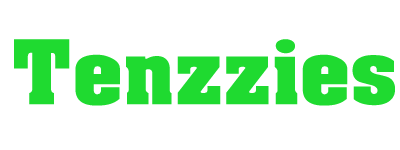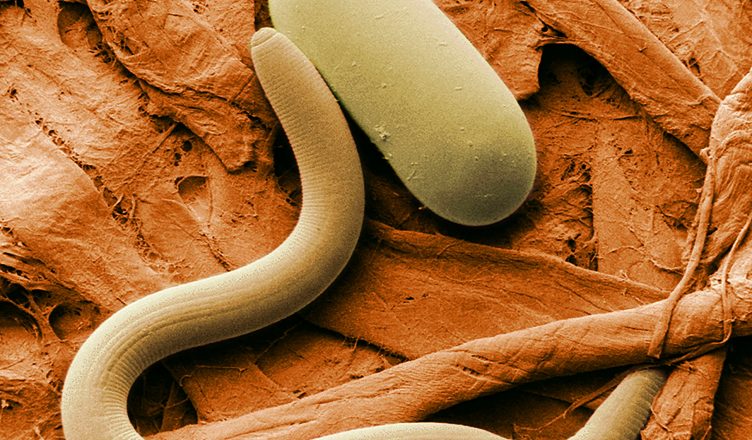In part 1, we listed 10 dangerous parasite that leech off their human hosts, bringing discomfort, body damage, and sometimes even death to their unfortunate victim. In this list, we present 10 more dangerous parasites that can consume and eventually destroy their human host if left unchecked.
10. Hookworm
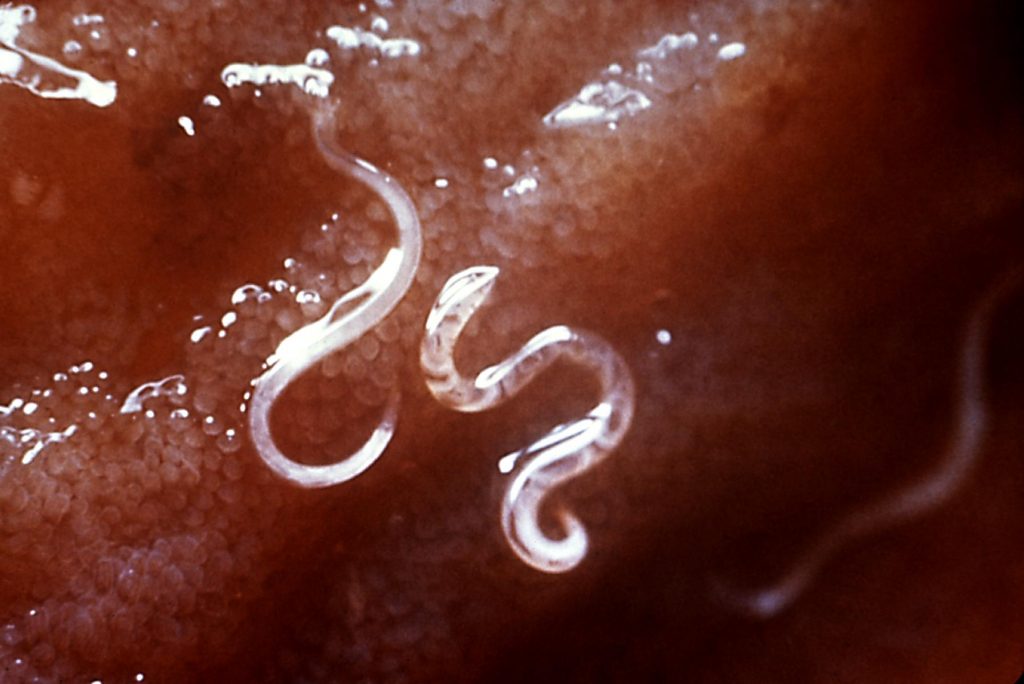
Hookworms are a type of bloodsucking roundworm that lives in intestines of their hosts. There are two primary species of hookworms that affect humans. These hookworms’ size range from 5mm to 13mm (0.2 to 0.5 inches).
Hookworms begins their lifecycle when their eggs are pushed out of a host’s body via their excrement. They develop into larvae in the soil, and wait patiently for a new host to step on infested soil. When a potential host comes along, the larvae enter the host’s body from the soles of their base feet. They then make their way to the lungs of the host, where they are coughed up and swallowed back down by the host.
The hookworms make their home inside their host’s gut. These nasty worms suck up nutrients from their victim, causing symptoms such as stomachache, weight loss, tiredness and diarrhea. Children are especially affected by them, and can become malnourished. The worms grow and mate in the intestines, releasing thousands of tiny eggs each day.
Hookworm infection can be detected from a stool sample. If eggs are found under a microscope, the person is confirmed with carrying the parasite. Anti-parasitic drugs can be used to kill the adult worms in three days or less.
The best way to not get infected with hookworms is to avoid walking barefoot in the soil.
9. Giardia Lamblia
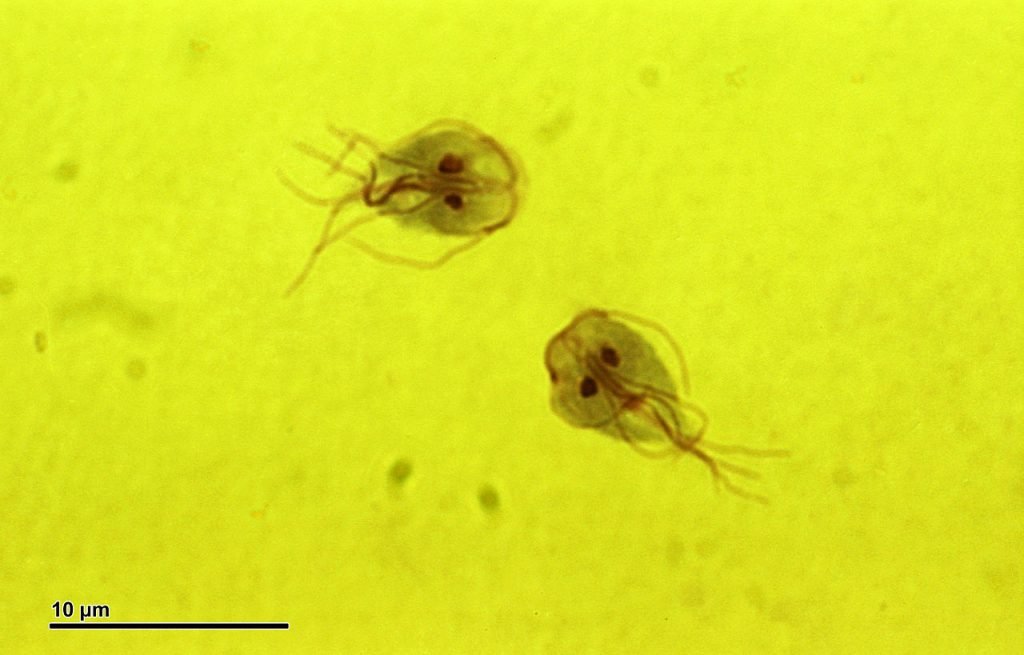
Giardia Lamblia are tiny protozoan that live in ponds, lakes and rivers as cysts. When they are ingested by a human when they drink directly from the pond, they make their way to the intestines, where they are released from their pouches by digestive juices.
These protozoa, now active, eat and multiply rapidly in the host’s gut. They cause a disease called giardiasis, or beaver fever. Symptoms include diarrhea, stomachaches and nausea. Lost their protective cysts mean that these protozoa cannot survive without a host. Inside their cysts, however, they can remain dormant for an extremely long time.
Stool samples can be tested to see if a person is infected. Infected people can be treated with anti-parasitic drugs, or allow their bodies to get rid of the parasite naturally. Although antibodies can fight off these parasites, conditions like IBS (Irritable Bowel Syndrome) can develop due to lack of treatment.
Don’t drink unfiltered water if you don’t want to get this parasite.
8. Rat lungworm
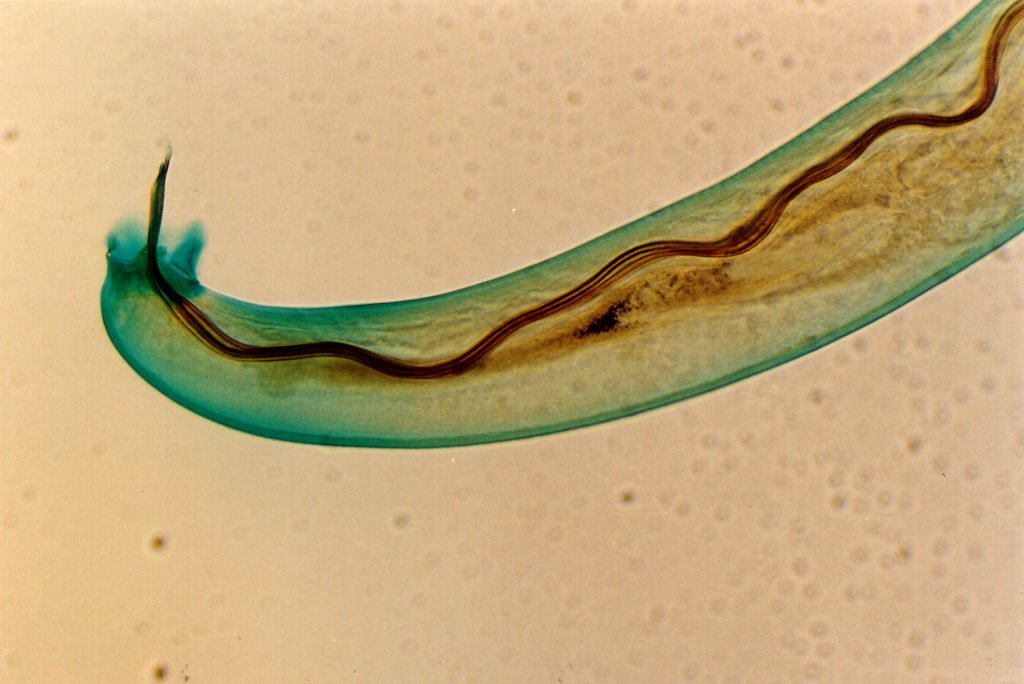
The rat lungworm is a parasite that thrives in the animal intestines. These worms hail from the same family as hookworms, and each worm can grow up to 0.8 inch (2cm). Mainly hosted by snail, slugs and rodents, humans are not their ideal host.
Rat lungworms begins its life as a larvae in the snail or slug’s body. The parasite enters the rat’s body when it eats the snail, and move to its lungs. The larvae then matures and mate in the rat’s lungs. Lungworm eggs leave the rat’s body via its droppings. When a snail or slug gobbles down infected rat poop, the life cycle is completed.
Although the rat lungworm do not usually attack people, humans can accidently eat them if they eat unwashed vegetables. When humans ingest the rat lungworm, the worm tries to procreate the usual way it did with rats. However, they usually end up getting kicked out of the human gut by antibodies instead.
There could be complications sometimes though. The worm can get stuck in human intestines, causing inflammation. In more serious cases, the worms can get lost in the human body, and end up in the nervous system of the human instead. These parasites then make their way into the brain, resulting in swelling of brain tissue, causing meningitis. Other symptoms include fever, stiff neck, throwing up and migraines.
There is no vaccine for the rat lungworm, and surgery is needed to remove the worm from the intestines or brain. To avoid getting this dangerous parasite, always ensure that fresh produce is washed and avoid handling wild rodents and snails.
7. Pork Tapeworm

Pork tapeworms are one of the rare parasites that count humans as one of their primary hosts. The other host for the worm is hogs. Other worms are usually small, but these tapeworms can grow up to 8 meters (26 foot) in length!
The life of a pork tapeworm begins as an egg in human feces, where they are eaten by a pig. Hatching into larvae in the pig’s stomach, the worms then migrate to the pig’s muscle tissues, where they form cysts, waiting for the pig to be slaughtered and eaten by another predator, such as a human. When a human eats the undercooked, infested pork, cysts swallowed by the human hatches in the gut, where it steal nutrients and grows. After the worms mature, they mate and lay eggs which are passed out in human stool, and the lifecycle is complete.
Most people who contract pork tapeworm have mild stomach discomfort, or none at all. This is the more benignant form of infection, when people ate undercooked pork and unwittingly eat the parasites’ cyst in the pig’s muscle tissue, like how the parasites intended it to be.
The more serious form of the disease happens when people ingest feces from an infected pig or human. When that happens, the eggs travel to the muscle tissue of the human, forming cysts in the person instead of the pig. This condition is called Cysticercosis, and can cause symptoms such as swollen tissue muscles and fever.
Depending on where the parasite travels to, the worm can end up in the eyeballs, skin, or even the brain. In the eyes, they can cause internal bleeding as the worms feed on the eyeball, and eventually cause the victim to go blind. The condition can be life threatening if the worm gets into the brain. As the worm eats away at the brain, it can cause meningitis due to the high pressure in the brain, as well as seizures and back pain.
The best way to avoid getting this nasty bugger is to not eat raw or undercooked pork.
6. Leishmania
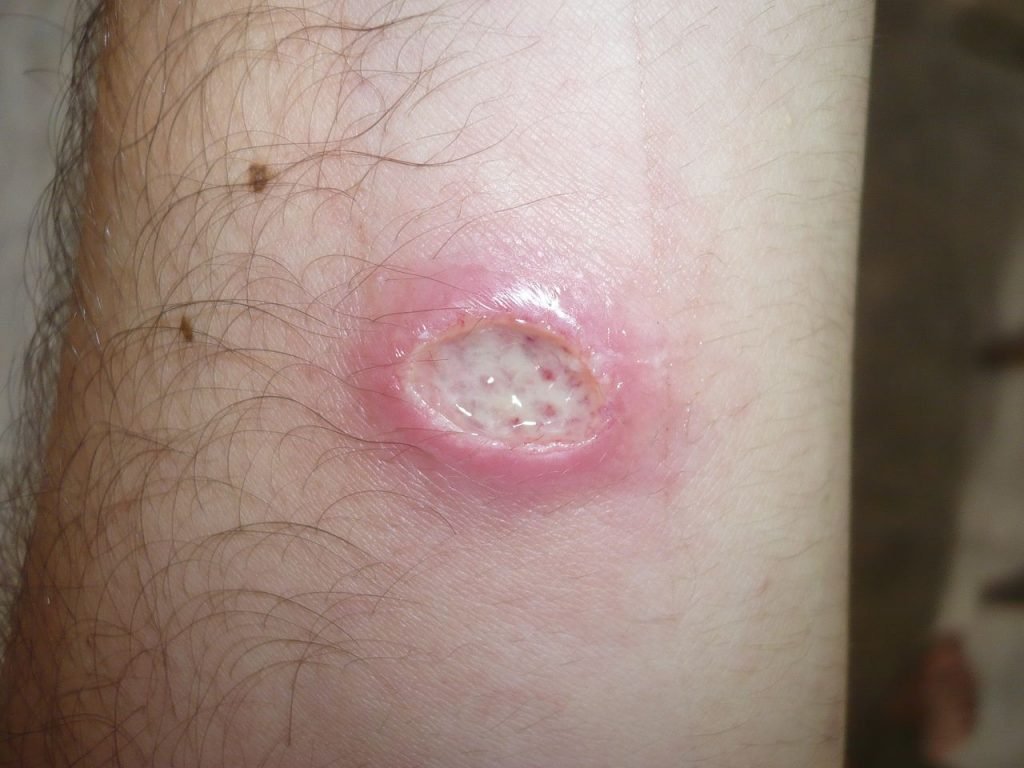
Leishmania is a group of protozoan parasite that are transmitted by sand flies. A sand fly is a tiny insect about a quarter the size of a mosquito. Sand flies mainly live in tropical areas. Like mosquitos, they feed on blood of mammals, including humans.
The disease caused by Leishmania parasite is known as Leishmaniasis. There are three variants of diseases that the parasite can infect humans with. The most common form is known as Cutaneous Leishmaniasis. This happens when Leishmania enters the skin, causing unsightly sores which can take months to recover from. The sores can cause large patches of scars if there are multiple sand fly bites on the body.
The second type, Mucosal leishmaniasis, is a rare form of the disease. Caused only by certain species in the parasite family, the sores cause painful ulcers in delicate tissues such as nose and mouth.
The final and most deadly form of Leishmaniasis is Visceral Leishmaniasis. The parasites cause internal organs such as liver and spleen to become enlarged to the point that they become damaged, and cause symptoms such as anemia and high fever. This can happen many months or years after the sand fly bite, and have no signs of any illness before that. Death is highly likely if left untreated.
Anti-parasite drugs are available to kill the protozoans, but there is no effective treatment for scars left by the parasite. The best way to not get bitten by a sand fly is to use insect repellent and use mosquito nets at night when sleeping in areas that these flies are common.
5. Lung flukes

Lung flukes are a type of flatworms that live mainly in aquatic snails and crustaceans. The mature fluke can grow to about 15mm (0.59 inches). They have a complicated lifecycle involving 3 or most hosts, with the end goal of getting into a mammal predator.
The life cycle of a lung fluke begins when the larvae get into the foot muscle of a freshwater snail. The larvae grows and molts several times in the snail. When the snail gets eaten by a crab, they move into the crab’s intestines. Here they form cysts, and wait for the crab to be eaten by another predator, such as a human.
When a human eats undercooked or raw crustaceans, the cyst are released in the gut. From there, they move to the lungs, where they mature into adult worms. They form cysts to mate and the female flatworm produce eggs, which are swallowed back into the gut when the human coughs. The eggs then land back into the water when the feces are released there.
Lung flukes typically cause little to no symptoms when they get inside a human body. For some others, they can develop symptoms such as tuberculosis when the worms are in their lungs. More serious cases happen when the lung fluke takes the wrong turn while navigating to the lungs and ends up in the brain.
When they are in the brain, these trapped flukes are unable to reproduce in the normal way. Instead, they breed and deposit their eggs in the brain, causing the human host to develop symptoms such as seizures, severe headaches and vomiting.
There are medicine to kill the parasite, but any lasting damage they did in the human body cannot be undone. The best way not to get these parasites is not to eat raw, undercooked seafood.
4. Loa Loa
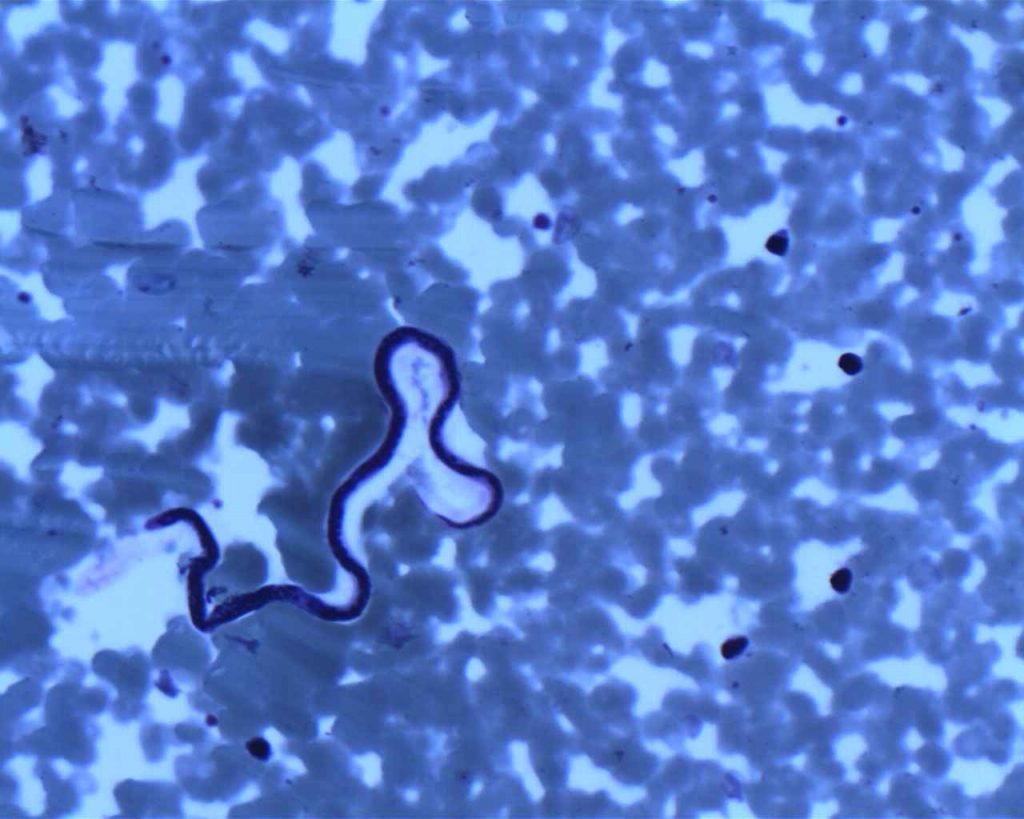
Loa Loa, or the African eye worm, is a type of parasitic filarial worm that can live in the human body. Loa Loa are one of the parasites that include humans as a primary host. Like the parasites that cause Elephantiasis, Loa Loa can cause damage to the host, affecting the eyes as well as the skin. This condition is called Loiasis.
The lifecycle of the African eye worm begins when the eggs develop into larvae in an infected deer fly’s gut. The larvae waits for the fly to take a blood meal from a human, and move into the person’s skin. As the larvae grow and move beneath the skin of the human host, it may cause an allergic reaction known as Calabar swelling, where the fluid fill up the areas where the worms passed, causing skin to swell up.
After maturing, the adult Loa Loa mate and lay eggs. During the day, the larvae worms linger around in the bloodstream, spinal fluid and waste material of the host, waiting to be picked up by a deer fly. At night, when deer flies are less active, the worms hide in the lungs. When a deer fly bites a human, the waiting worm larvae is sucked up by the fly, and the lifecycle is complete.
Most people who get infected by the parasite do not know until the worm moves around in the host’s eye and becomes clearly visible. This movement cause searing pain and inflammation in the host’s eyes. Other than the eyes, Loa Loa can virtually lodge themselves in any organ, including the heart and sexual organs.
There is no vaccine against this parasite, but anti-parasitic drugs can be administered to kill both adult and larvae worms. The best way to avoid getting this parasite is to use insect repellent and wearing long sleeve clothes.
3. Trypanosoma brucei

The protozoan parasites from the family Trypanosoma brucei cause the dreaded African sleeping sickness. As the name suggests, this parasite is most endemic in African countries. The parasites are spread by the tsetse flies, which only live in the African continent, and feed on the blood of mammals such as humans, cows and deer.
There are actually two variants of the sleeping sickness, the East and West versions, both of which are caused by the same family of parasites. Most cases of the illness are of the the West variant, which is a slower acting disease. The East version accounts for about two percent of all reported occurrences of the disease.
These tricky parasites exist in two forms, the long thin form and short thick form. In the tsetse fly, the parasite are in their short and thick form. After the tsetse fly drink a mammal’s blood, the parasite enters the new host from the fly’s stinger. Transforming into their long thin form, the protozoan divide to create more of themselves in the host’s bloodstream and lymphatic system, while the newly formed cells going into their short thick form. The parasites in their long slender form get into the host’s central nervous system, while the short thick ones wait to be picked up by a tsetse fly. Other forms of transmission of this parasite include mother to newborn and blood transfusion.
Early symptoms of African sleeping sickness include fever, itchiness and swollen lymph nodes. An infected person has the best chance of recovery if treated in this stage. In the later stages, when the parasite has infected the central nervous system, more serious symptoms such as speech problems, coordination difficulties and sleeping throughout the day occur. Powerful drugs are needed to treat the patient at this point, with the rate of recovery going down rapidly. If left untreated, the African sleeping sickness is almost guaranteed to cause death.
Since the disease has no cure or vaccine, people who contract the disease need to get a checkup regularly with their doctors for two years to ensure that the parasite infestation does not reoccur. To prevent from getting this vile parasite, wear long sleeved clothes, and using insect repellent while in Africa.
2. Schistosoma
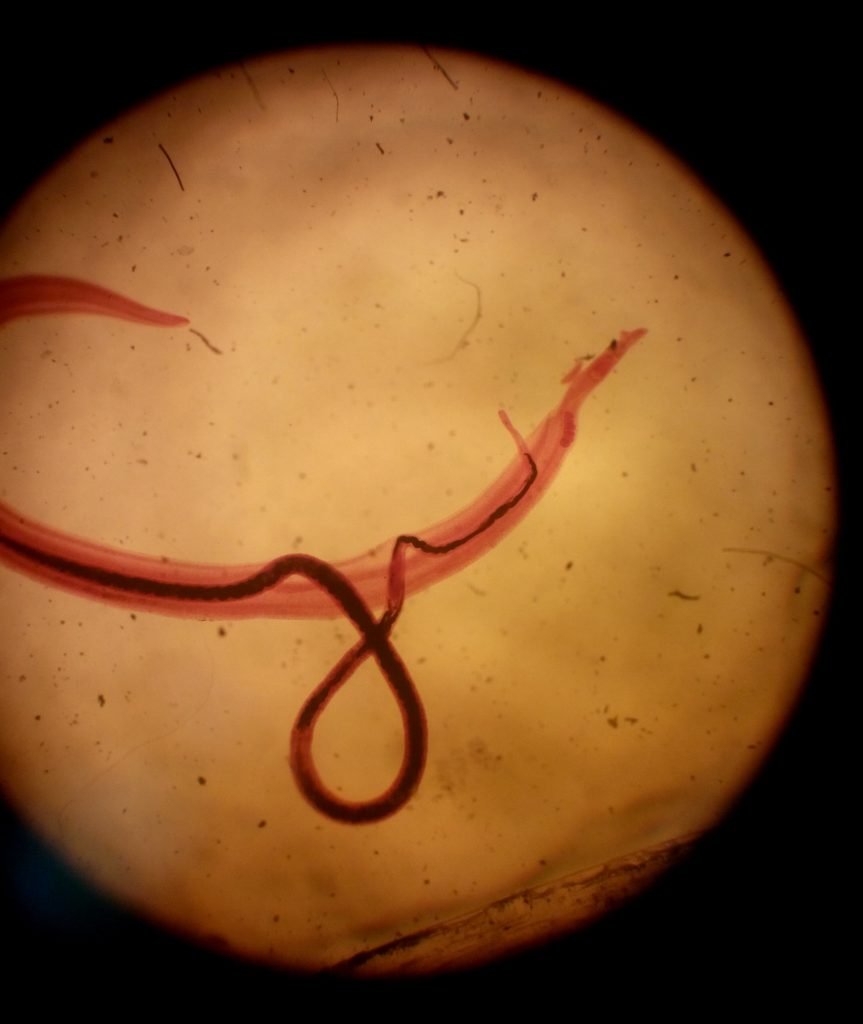
Schistosomiasis, A.K.A snail fever, is a disease caused by a type of flatworm parasite known as Schistosoma or blood flukes. This parasites live in tropical areas, where there are bodies of freshwater such as rivers and lakes. There are two types of the disease: Intestinal schistosomiasis and Urogenital schistosomiasis.
The flatworm tunnels into their human host through their soles when he or she steps into freshwater harboring the parasite larvae. The tiny larvae then develops in the human body, and copulate. Female worms lay their eggs in the intestines of the host, while the human host releases the eggs into the water when they excrete. Aquatic snails then eat the feces. The flatworm eggs hatch in the snails’ gut, and grow into larvae. The larvae then exit the snail to wait for a mammalian host.
Intestinal schistosomiasis happens when the parasites’ eggs become stuck in the host’s gut. It can cause conditions such as diarrhea, stomach cramps and bloody stools. The host’s colon may be attacked by its own immune system as the white blood cells attempt to kill the flatworms, resulting in intestine blockage and internal bleeding. Buildup of fluid in the belly resembling a beer gut can also happen.
Urogenital schistosomiasis typically causes bloody urine. As the worms block up the urinary track, it can cause bladder calcification and kidney failure. If left untreated in late stages, bladder cancer can occur. Both types cause itch rashes on the skin, an enlarged spleen and liver.
While no vaccine is available, drugs have been developed to kill the parasites rapidly in the human host. The best way to avoid getting these flatworms is to avoid swimming in lakes and rivers known to host the parasite, and to boil water before drinking.
1. Trypanosoma cruzi
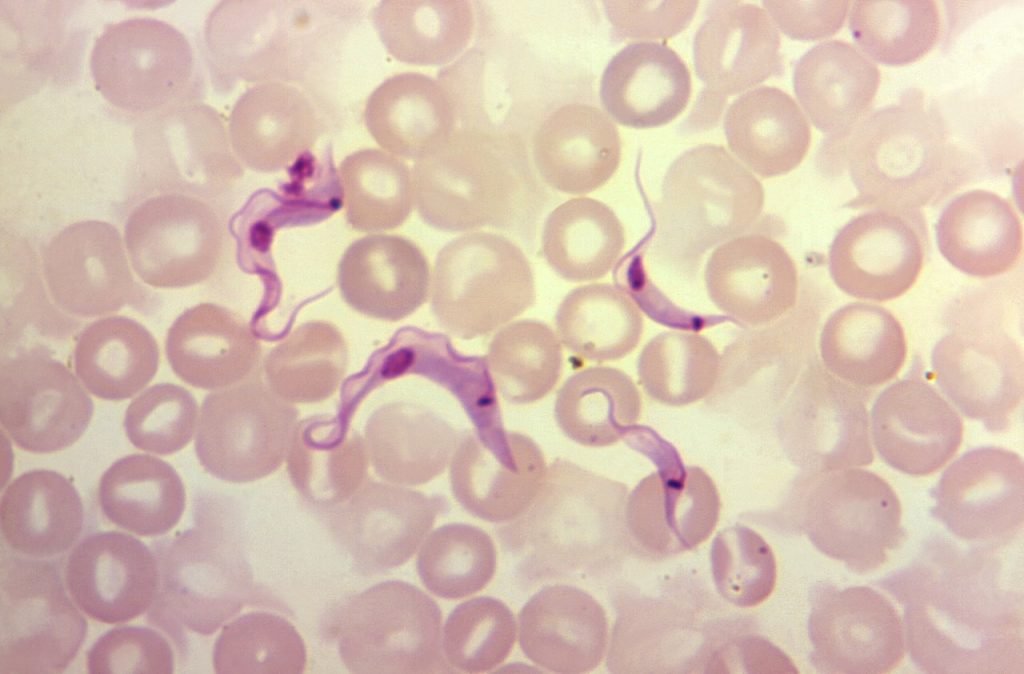
The protozoan Trypanosoma cruzi causes Chagas disease. Transmitted by triatomine bugs, or kissing bugs, these parasites tunnel through their host’s tissue, gobbling down blood cells and lymph fluid. Chagas disease infection is mainly found in the Americas region.
The lifecycle of the protozoan begin when a kissing bug drinks blood from a mammal like a human. After drinking their fill, the kissing bug takes a dump containing the parasite on the human’s face, and the parasite enter their new host’s body through wound or skin pore when the unwitting host scratches at the itch.
Inside the person’s body, the parasite multiply rapidly, attacking internal organs and tissue. When an uninfected kissing bug drinks the blood of an infected human, some of the protozoa travel with the blood into the bug, hitching a ride to a new human home. Infection can also occur if food is contaminated with the stool of the kissing bug.
Symptoms of infection includes fever and swelling on skin where the parasite entered the host. The spleen enlarges about a fortnight after the bite. These symptoms usually goes away on its own without any medical attention.
The next stage of infection happens a very long time later, usually after several decades. The parasite living and multiplying non-stop for years in the host’s body can cause heart problems like irregular heartbeat and heart failure, or intestinal problems like enlarged colon, leading to eating or defecation problems.
Although there are anti-parasitic medication for this parasite, long term damage from the parasite requires additional medication or machines like pacemakers. There is no vaccine for prevention of this parasite. The best way to prevent contracting Chagas disease is to use insect repellent and avoid eating raw fruits and vegetables.
Bonus: Babesia (aka Nuttallia) – Babesiosis (malaria-like disease)
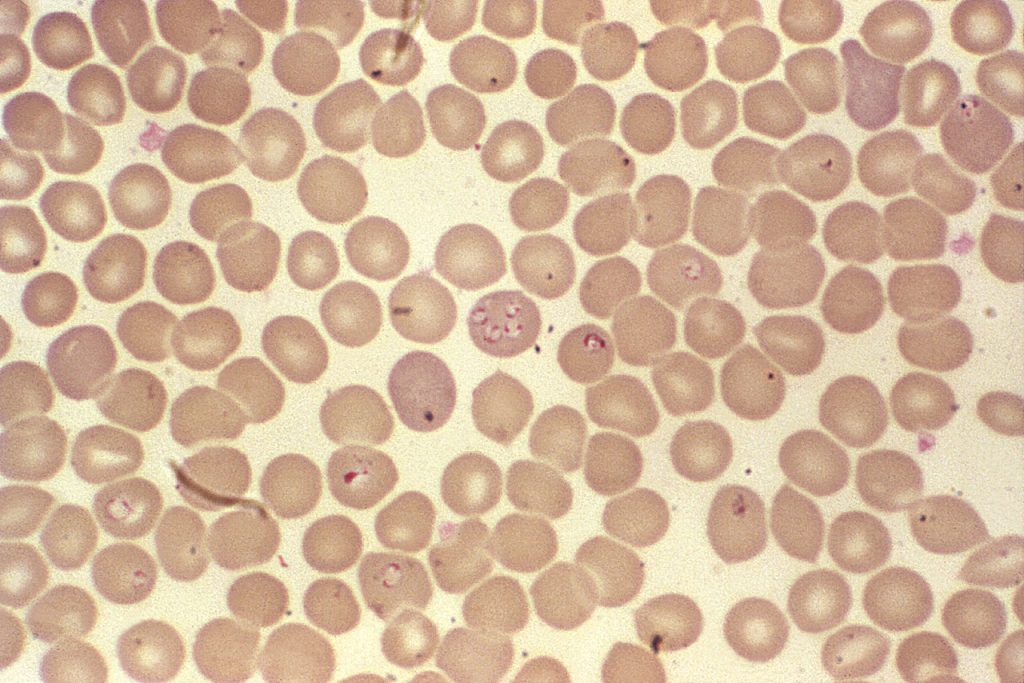
Babesia is a protozoan parasite spread by deer ticks, causing a condition known as Babesiosis. This disease is very similar to malaria, where the parasite destroys red blood cells. In human, Babesia is often transmitted alongside Lyme disease. This parasite often strikes in midwestern US states, and several cities in Europe.
This parasite usually affects cows, sheep and rats, but when the tick drinks blood from a human, the human can become a host for the parasite. When that happens, the protozoan enters the bloodstream, and multiply rapidly in red blood cells. The red blood cells are eventually destroyed, and the parasites move on to the next cell. When another tick bites an infected human, the parasites are sucked up by the tick, and the lifecycle is complete.
Babesiosis can cause symptoms such as fever, chills and fatigue. Left untreated, Babesiosia can lead to low blood pressure, anemia, heart failure and death. As Babesiosis has very similar symptoms to Malaria, it is often misdiagnosed, but anti-parasitic medication for Malaria is also effective for Babesiosis. People with weaker immune systems may need to administer the medication several times to get rid of all the parasites.
As the tick can take up to 48 hours to transmit the parasite, the best way to prevent getting this parasite is to carefully check and remove any attached ticks after walking in the woods. Wearing long sleeved shirts also help to reduce the chance of any ticks sticking onto your skin.
Do you have experience with any of these deadly parasites? Leave your comments below!
